Catholic Customs
 |
 |
 |
 |
 |
 |
 |
How Our Forefathers Celebrated Pentecost
Catholic peoples throughout the world have always celebrated the great feast of Pentecost with much fervor. This festival, one of the most important feasts of the year, inspired the people to develop many wonderful customs to which every one, both young and old, looked forward the whole year.
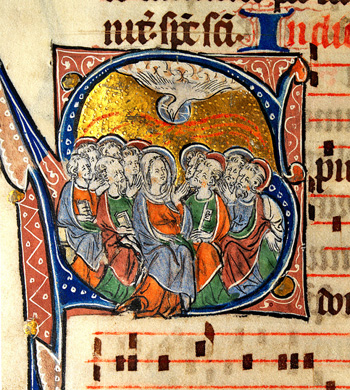 In medieval times, Pentecost and its octave were highly privileged days, with servile work and civil and law proceedings banned during the whole octave. On Pentecost Eve baptism was administered in a solemn vigil similar to that of the old Easter Vigil. Then, the newly baptized would wear white garments on Pentecost Sunday,
a custom that led to the day being called Whit Sunday. For a feast of such high importance, it is not surprising that preparations and festivities on the Eve of Pentecost anticipate the great day.
In medieval times, Pentecost and its octave were highly privileged days, with servile work and civil and law proceedings banned during the whole octave. On Pentecost Eve baptism was administered in a solemn vigil similar to that of the old Easter Vigil. Then, the newly baptized would wear white garments on Pentecost Sunday,
a custom that led to the day being called Whit Sunday. For a feast of such high importance, it is not surprising that preparations and festivities on the Eve of Pentecost anticipate the great day.
One lively festivity observed by the men of Austria and many Western European countries was to salute the feast with the cracking of whips, Pfingstschnalzen, and the firing of their ancient guns, Pfingstschiessen (see video here). On Whitsun Eve in Little Poland, the young men built bonfires, played music and danced, at times jumping over the fire. Lighting homemade torches, they would carry them through the rye fields, a ceremony that would be repeated on Whit Monday through the wheat fields, praying for abundant harvests.
One popular custom in many places was to rise before dawn on Pentecost morning to pray and watch the sun rise on the hilltops. An English saying shows the intent: "Whatsoever a man doth ask of God upon Whitsunday morning, at the instant when the Sun arise and play, that will God grant."
Another custom was to walk barefoot through the grass in the Pentecost dew, believed to bring special blessings as the sequence to the Holy Ghost says: "Heal our wounds, our strength renew, on our dryness pour thy dew." Some of this dew was collected on bread and fed to the animals to keep them from harm.
Symbolism of Pentecost
The Festival of Pentecost was always accompanied by beautiful decorations made with the newly budding plants of Summer. How fitting that the Catholic peoples of old found the symbolic aspects of each season to incorporate into their celebrations of special feast days. For, through His Church, God determined when His feast days should be held and each is placed in its proper season.
Dom Guéranger explains this beautifully with regard to Pentecost: "The Spirit of the Father and the Son came in the season that harmonizes with His own divine characteristic. He is a consuming Fire; He comes into the world when Spring is in its pride, and sunshine decks our earth with loveliest flowers." (The Liturgical Year, Vol. 9, p. 292).
 The greens brought to adorn church and home were symbolic of new life, representing the new life given to the Church through the Holy Ghost. In every country of Europe, the people collected boughs of trees and flowers local to their region. These were often made into beautiful wreaths or ornaments that were placed on doorways, windowsills, gates, wagons, animals, and even the altar and statues of the churches.
The greens brought to adorn church and home were symbolic of new life, representing the new life given to the Church through the Holy Ghost. In every country of Europe, the people collected boughs of trees and flowers local to their region. These were often made into beautiful wreaths or ornaments that were placed on doorways, windowsills, gates, wagons, animals, and even the altar and statues of the churches.
The Columbine flower, which typically blooms around the time of Pentecost, was known as the Pentecost flower. Appropriately named after doves, or columba in Latin, its petals come similarly shaped. With continued focus on the shape of their buds, red roses were also associated with Pentecost during the Middle Ages. Their shape and color were emblematic of the tongues of fire which rested on the heads of the 120 disciples, and poured forth the sweet gifts of love and grace on the infant Church. (Ibid., vol. 9, p. 294)
All over Europe Whitsuntide was a time when people gathered together for festivities in the beautiful verdure of the Spring countryside. Picnics, walks in the woods and hills, dances, singing, parades, plays, games and races were all popular.
Some of the traditional customs associated with May Day, such as the May pole and May queens, reappeared on Pentecost. Many places had a Whitsun bride or queen chosen by the young girls of the village. This young queen, adorned with ribbons and a crown of flowers, processed with her small court of girls through the streets, singing the traditional song of the Whitsun flower.
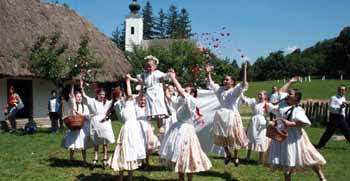 In Holland, the small entourage, often escorted by the boys of the village, processed from house to house asking for eggs and money for the Pentecost feast by singing this charming song:
In Holland, the small entourage, often escorted by the boys of the village, processed from house to house asking for eggs and money for the Pentecost feast by singing this charming song:
"Here we come with a pretty Whitsun Bride. She is dressed so prettily.
Give something, keep something.
A rich man lives here
Who can give much.
God will reward him
With a hundred thousand crowns,
With a hundred thousand bows.
Here we come with a pretty Whitsun Bride."
(Dorothy Gladys Spicer, Festivals of Western Europe, p. 148)
In Hungary, the Whitsun Queen was elected by the girls of the village. A procession of four girls attended the white-clad queen, holding a colorful handkerchief over her head to cover her face as they arrived at a house. There, they performed a special dance and song around the Queen, showering her with flower petals. At times, they lifted her in the air and prayed for a good flax, wheat or wine harvest. "May the flax grow as high as our Queen."
Some places had a Whitsun King as well as a Queen. In many villages, this kingship had privileges that lasted a whole year: not being held accountable for minor offenses before court, being the honored guest at festivals where young men waited upon him, etc. In western Hungary, the young men chose the best among them to be king based on his performance in a horse race. The horse races often tested the riders' skill with obstacles and feats such as grabbing a kerchief on a pole or pulling off a live goose's head from a hanging string.
The village people in every country took the Whitsun King or Queen ceremonies very seriously. No joking or foolishness, as is so common in modern parades or celebrations, degraded the dignity of their local "chosen royal." The peasants showed great respect and love for royalty, a behavior that runs so contrary to many modern revolutionary myths about them.
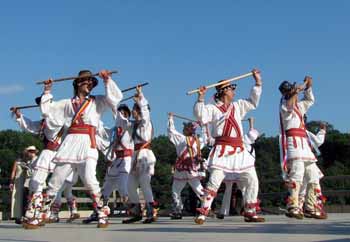 In other processions throughout Europe shepherds adorned their cattle, oxen, or sheep with green branches, flowers and wreaths. In the Kujawy region of Poland, a race was held among the shepherds, who wore cattle or ox horns. The winner was crowned "king" and chose a "court," whereas the loser was required to tend the others' livestock for three days. A feast was then prepared by the court members for all present, and an ox, elaborately decorated, was processed through the village amid the cracks of men's whips and the songs of the villagers.
In other processions throughout Europe shepherds adorned their cattle, oxen, or sheep with green branches, flowers and wreaths. In the Kujawy region of Poland, a race was held among the shepherds, who wore cattle or ox horns. The winner was crowned "king" and chose a "court," whereas the loser was required to tend the others' livestock for three days. A feast was then prepared by the court members for all present, and an ox, elaborately decorated, was processed through the village amid the cracks of men's whips and the songs of the villagers.
An ancient tradition in England is the performance of the Morris Dancers, lasting from May Day to Whit Sunday (see here and here). Every village parish had a Morris dance, feast and Whitsun Ale that was enjoyed by all the classes. The Morris dancers were a group of men dressed in white, wearing black beaver hats and bands of bells around their legs. They were clothed with ribbons on their shoulders, arms and chest, often in the colors of the leading family or noble of the parish. Every movement of the dance was in strict unison, from the waving of their handkerchiefs to the clapping of hands or clashing and twirling of staffs. A tabor and a pipe accompanied the dance around the maypole on the village green.
Every region in every Catholic country had its own unique processions and customs, all celebrating the holy Feast that unites all peoples of the true Faith. One custom shared by all was the Whitsun feast.
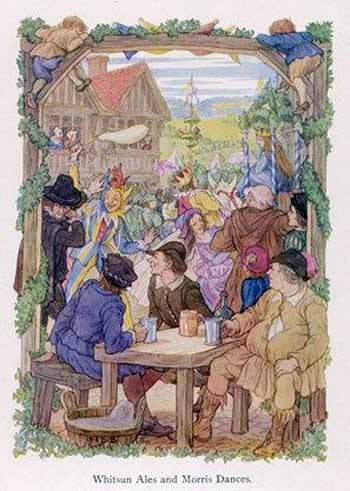 In every household, from palaces to peasant cottages, a carved and painted wooden dove, made by one of the men of the house, was suspended above the dinner table. Sometimes this dove was even encased in a globe of glass. To honor the Holy Ghost, who descended in the form of a dove at Our Lord's Baptism, doves or other small birds were traditionally eaten on this day, and many of the traditional dishes of different countries were rich in milk, cream and eggs.
In every household, from palaces to peasant cottages, a carved and painted wooden dove, made by one of the men of the house, was suspended above the dinner table. Sometimes this dove was even encased in a globe of glass. To honor the Holy Ghost, who descended in the form of a dove at Our Lord's Baptism, doves or other small birds were traditionally eaten on this day, and many of the traditional dishes of different countries were rich in milk, cream and eggs.
Christian charity would not allow the poor to be forgotten on this grand Feast. Especially in England, the poor were often provided special doles, and the Whitsun Ales were served to all. Even the English country farmers would give milk to all who came by their homes. In some places, poor women would be permitted to go to the farm houses to milk the cow. This milk was then distributed to their families by the masters of each house to their respective families.
It is fitting to find ways to commemorate this feast as our Catholic forefathers did. Simple things can make the day more festive and joyous, such as decorating the house with greenery and Pentecost flowers like the columbine, red peony, red roses or rose petals.
How charming it would be to have a well-set dinner table, adorned throughout the entire octave of Pentecost with greenery and flowers, a white tablecloth and the dove suspended over the table. For communities or families, the return to a joyful and sacral procession – either with a Whitsun Queen or King – could bring this most important feast to life, with due festivity and honor.
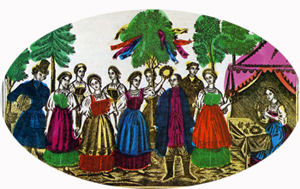

One lively festivity observed by the men of Austria and many Western European countries was to salute the feast with the cracking of whips, Pfingstschnalzen, and the firing of their ancient guns, Pfingstschiessen (see video here). On Whitsun Eve in Little Poland, the young men built bonfires, played music and danced, at times jumping over the fire. Lighting homemade torches, they would carry them through the rye fields, a ceremony that would be repeated on Whit Monday through the wheat fields, praying for abundant harvests.
One popular custom in many places was to rise before dawn on Pentecost morning to pray and watch the sun rise on the hilltops. An English saying shows the intent: "Whatsoever a man doth ask of God upon Whitsunday morning, at the instant when the Sun arise and play, that will God grant."
Another custom was to walk barefoot through the grass in the Pentecost dew, believed to bring special blessings as the sequence to the Holy Ghost says: "Heal our wounds, our strength renew, on our dryness pour thy dew." Some of this dew was collected on bread and fed to the animals to keep them from harm.
Symbolism of Pentecost
The Festival of Pentecost was always accompanied by beautiful decorations made with the newly budding plants of Summer. How fitting that the Catholic peoples of old found the symbolic aspects of each season to incorporate into their celebrations of special feast days. For, through His Church, God determined when His feast days should be held and each is placed in its proper season.
Dom Guéranger explains this beautifully with regard to Pentecost: "The Spirit of the Father and the Son came in the season that harmonizes with His own divine characteristic. He is a consuming Fire; He comes into the world when Spring is in its pride, and sunshine decks our earth with loveliest flowers." (The Liturgical Year, Vol. 9, p. 292).

Slavic ladies decorate their house with greens for Whitsun Sunday
The Columbine flower, which typically blooms around the time of Pentecost, was known as the Pentecost flower. Appropriately named after doves, or columba in Latin, its petals come similarly shaped. With continued focus on the shape of their buds, red roses were also associated with Pentecost during the Middle Ages. Their shape and color were emblematic of the tongues of fire which rested on the heads of the 120 disciples, and poured forth the sweet gifts of love and grace on the infant Church. (Ibid., vol. 9, p. 294)
All over Europe Whitsuntide was a time when people gathered together for festivities in the beautiful verdure of the Spring countryside. Picnics, walks in the woods and hills, dances, singing, parades, plays, games and races were all popular.
Some of the traditional customs associated with May Day, such as the May pole and May queens, reappeared on Pentecost. Many places had a Whitsun bride or queen chosen by the young girls of the village. This young queen, adorned with ribbons and a crown of flowers, processed with her small court of girls through the streets, singing the traditional song of the Whitsun flower.

Hungarian girls lift the Whitsun Queen; below, cows adorned with flowers for a Whitsun procession in the Alps
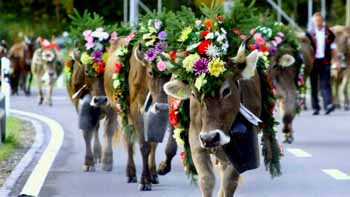
"Here we come with a pretty Whitsun Bride. She is dressed so prettily.
Give something, keep something.
A rich man lives here
Who can give much.
God will reward him
With a hundred thousand crowns,
With a hundred thousand bows.
Here we come with a pretty Whitsun Bride."
(Dorothy Gladys Spicer, Festivals of Western Europe, p. 148)
In Hungary, the Whitsun Queen was elected by the girls of the village. A procession of four girls attended the white-clad queen, holding a colorful handkerchief over her head to cover her face as they arrived at a house. There, they performed a special dance and song around the Queen, showering her with flower petals. At times, they lifted her in the air and prayed for a good flax, wheat or wine harvest. "May the flax grow as high as our Queen."
Some places had a Whitsun King as well as a Queen. In many villages, this kingship had privileges that lasted a whole year: not being held accountable for minor offenses before court, being the honored guest at festivals where young men waited upon him, etc. In western Hungary, the young men chose the best among them to be king based on his performance in a horse race. The horse races often tested the riders' skill with obstacles and feats such as grabbing a kerchief on a pole or pulling off a live goose's head from a hanging string.
The village people in every country took the Whitsun King or Queen ceremonies very seriously. No joking or foolishness, as is so common in modern parades or celebrations, degraded the dignity of their local "chosen royal." The peasants showed great respect and love for royalty, a behavior that runs so contrary to many modern revolutionary myths about them.

Romanians perform their traditional Whitsun dance; below, the Morris Dancers of England
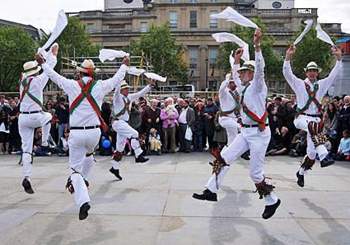
An ancient tradition in England is the performance of the Morris Dancers, lasting from May Day to Whit Sunday (see here and here). Every village parish had a Morris dance, feast and Whitsun Ale that was enjoyed by all the classes. The Morris dancers were a group of men dressed in white, wearing black beaver hats and bands of bells around their legs. They were clothed with ribbons on their shoulders, arms and chest, often in the colors of the leading family or noble of the parish. Every movement of the dance was in strict unison, from the waving of their handkerchiefs to the clapping of hands or clashing and twirling of staffs. A tabor and a pipe accompanied the dance around the maypole on the village green.
Every region in every Catholic country had its own unique processions and customs, all celebrating the holy Feast that unites all peoples of the true Faith. One custom shared by all was the Whitsun feast.

A depiction of the Whitsun Ales in times past
Christian charity would not allow the poor to be forgotten on this grand Feast. Especially in England, the poor were often provided special doles, and the Whitsun Ales were served to all. Even the English country farmers would give milk to all who came by their homes. In some places, poor women would be permitted to go to the farm houses to milk the cow. This milk was then distributed to their families by the masters of each house to their respective families.
It is fitting to find ways to commemorate this feast as our Catholic forefathers did. Simple things can make the day more festive and joyous, such as decorating the house with greenery and Pentecost flowers like the columbine, red peony, red roses or rose petals.
How charming it would be to have a well-set dinner table, adorned throughout the entire octave of Pentecost with greenery and flowers, a white tablecloth and the dove suspended over the table. For communities or families, the return to a joyful and sacral procession – either with a Whitsun Queen or King – could bring this most important feast to life, with due festivity and honor.

A Ukrainian Whitsun festival

Posted May 31, 2020
______________________
______________________
 |
 |
 |
 |
 |
 |


